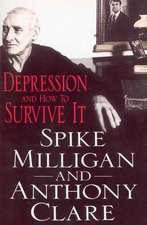How to Age in Place: Planning for a Happy, Independent, and Financially Secure Retirement
Autor PhD Languirand, Mary A., Robert F. PhD Bornsteinen Limba Engleză Paperback – 2 sep 2013
Do you want to retire happily in a home you love?
For millions of Americans, living in a nursing home or assisted living facility is not how they’d prefer to spend their retirement years. This is why more and more people are choosing to “age in place”—a burgeoning national movement that enables older adults to live independently and comfortably in a place of their own choosing.
Aging in place takes some planning and foresight—which is why clinical psychologists
and aging specialists Mary Languirand and Robert Bornstein have created this indispensable guidebook to take you through every step of the process. Useful, actionable advice on financial planning enables you to set aside the resources you need, while a detailed explanation of Universal Home Design will help you hire the right contractors and modify your home to make it safe and livable for the long-term. With concrete guidance for obtaining necessary social services, transportation assistance, health care, and even home maintenance help, How to Age in Place teaches you to anticipate problems before they arise and plan accordingly.
Whether you’re interested in a new post-retirement career, keeping your brain nimble, discovering (or rediscovering) your life’s purpose, or strengthening your social network, How to Age in Place will help you live the good life into your 80s and beyond. It’s never too late—or too early—to begin putting your plan in place.
Preț: 105.54 lei
Nou
Puncte Express: 158
Preț estimativ în valută:
20.20€ • 21.14$ • 16.81£
20.20€ • 21.14$ • 16.81£
Carte disponibilă
Livrare economică 10-24 martie
Preluare comenzi: 021 569.72.76
Specificații
ISBN-13: 9781607744160
ISBN-10: 1607744163
Pagini: 250
Ilustrații: ONE COLOR
Dimensiuni: 155 x 229 x 20 mm
Greutate: 0.32 kg
Editura: Ten Speed Press
ISBN-10: 1607744163
Pagini: 250
Ilustrații: ONE COLOR
Dimensiuni: 155 x 229 x 20 mm
Greutate: 0.32 kg
Editura: Ten Speed Press
Notă biografică
Drs. LANGUIRAND and BORNSTEIN coauthored When Someone You Love Needs Nursing Home, Assisted Living, or In-Home Care (Newmarket Press, 2002), which received the 2003 Caregiver Friendly Award from the National Association of Caregivers. They are also the authors of Healthy Dependency: Leaning on Others without Losing Yourself (Newmarket Press, 2003). Drs. LANGUIRAND and BORNSTEIN have extensive media experience, with national television appearances on The Discovery Channel and CNN Headline News; local television appearances in Philadelphia, Chicago, and Washington, DC; interviews on National Public Radio and other regional and national outlets; interactive chats on WebMD; and print coverage in the New York Times, Chicago Sun Times, San Francisco Chronicle, Atlanta Constitution, and Psychology Today.
MARY A. LANGUIRAND received her PhD in clinical psychology from the State University of New York at Buffalo in 1987, and completed an internship in clinical geropsychology at the R. H. Hutchings Psychiatric Center in Syracuse, New York. Dr. Languirand is coauthor of The Thinking Skills Workbook (Charles C. Thomas, 1980, 1984, 2000), a treatment manual for cognitive remediation in older adults. She now practices full-time in Long Island, New York, providing clinical services to individuals and families, and consulting to multidisciplinary treatment teams in skilled nursing facilities.
ROBERT F. BORNSTEIN received his PhD in clinical psychology from the State University of New York at Buffalo in 1986, completed an internship at the Upstate Medical Center in Syracuse, New York, and is professor of psychology at Adelphi University. Dr. Bornstein has published more than two hundred articles and book chapters on personality dynamics, diagnosis, assessment, and treatment. His research has been funded by grants from the National Institute of Mental Health and the National Science Foundation, and he received the American Psychological Association’s 2005 Theodore Millon Award for Excellence in Personality Research.
MARY A. LANGUIRAND received her PhD in clinical psychology from the State University of New York at Buffalo in 1987, and completed an internship in clinical geropsychology at the R. H. Hutchings Psychiatric Center in Syracuse, New York. Dr. Languirand is coauthor of The Thinking Skills Workbook (Charles C. Thomas, 1980, 1984, 2000), a treatment manual for cognitive remediation in older adults. She now practices full-time in Long Island, New York, providing clinical services to individuals and families, and consulting to multidisciplinary treatment teams in skilled nursing facilities.
ROBERT F. BORNSTEIN received his PhD in clinical psychology from the State University of New York at Buffalo in 1986, completed an internship at the Upstate Medical Center in Syracuse, New York, and is professor of psychology at Adelphi University. Dr. Bornstein has published more than two hundred articles and book chapters on personality dynamics, diagnosis, assessment, and treatment. His research has been funded by grants from the National Institute of Mental Health and the National Science Foundation, and he received the American Psychological Association’s 2005 Theodore Millon Award for Excellence in Personality Research.
Extras
What Is “Aging in Place”?
Aging in Place is a national movement aimed at enabling older adults to remain in their own homes by making available the social support, health care, and home maintenance services that people need to live safe, happy, productive lives in the community. Aging in place may mean continuing to live where you have lived for many years, or moving to a new residence (or new locale) that maximizes your ability to live independently.
Aging in place involves confronting some practical issues. If left undone, these issues can interfere with independent living:
• Financial planning
• Safe housing
• Neighborhood safety and “walkability”
• Accessibility of services (a pharmacy, for example, or nearby grocery store)
• Proactive medical and mental health care
• Opportunities for community, cultural, and civic engagement
• Sustainability to ensure long-term cost effectiveness
Beyond the practical issues, aging in place represents a philosophical shift—a social movement—which includes:
• Developing a new vision of healthy aging—a new attitude regarding needs of people in their 70s, 80s, and 90s, and the myriad ways in which older adults can contribute to society
• Creating innovative, efficient models of eldercare services that make aging in place economically viable for the individual and society
As you can see, aging in place requires some planning. But arranging those services that will enable you to live independently, safely, and comfortably, and stay active and engaged throughout your retirement, will help make aging in place the “new normal.”
Aging in Place is a national movement aimed at enabling older adults to remain in their own homes by making available the social support, health care, and home maintenance services that people need to live safe, happy, productive lives in the community. Aging in place may mean continuing to live where you have lived for many years, or moving to a new residence (or new locale) that maximizes your ability to live independently.
Aging in place involves confronting some practical issues. If left undone, these issues can interfere with independent living:
• Financial planning
• Safe housing
• Neighborhood safety and “walkability”
• Accessibility of services (a pharmacy, for example, or nearby grocery store)
• Proactive medical and mental health care
• Opportunities for community, cultural, and civic engagement
• Sustainability to ensure long-term cost effectiveness
Beyond the practical issues, aging in place represents a philosophical shift—a social movement—which includes:
• Developing a new vision of healthy aging—a new attitude regarding needs of people in their 70s, 80s, and 90s, and the myriad ways in which older adults can contribute to society
• Creating innovative, efficient models of eldercare services that make aging in place economically viable for the individual and society
As you can see, aging in place requires some planning. But arranging those services that will enable you to live independently, safely, and comfortably, and stay active and engaged throughout your retirement, will help make aging in place the “new normal.”
Recenzii
“This should be required reading for anyone over fifty. Much more than just a guide
to aging in place, this book provides a comprehensive roadmap for boomers
eager to enjoy the best retirement possible. Written in an engaging and upbeat style,
this is an incredibly informative, useful, and valuable read.”
—Nancy Collamer, author of Second-Act Careers and creator of MyLifestyleCareer.com
“This excellent book doesn’t tell you to stubbornly stay wherever you happen to live now. Rather, it helps you see decades into the future, so you can decide where to live, why
it’s best for you, and how to make it happen. Highly recommended!”
—John E. Nelson, author of What Color is Your Parachute? for Retirement
to aging in place, this book provides a comprehensive roadmap for boomers
eager to enjoy the best retirement possible. Written in an engaging and upbeat style,
this is an incredibly informative, useful, and valuable read.”
—Nancy Collamer, author of Second-Act Careers and creator of MyLifestyleCareer.com
“This excellent book doesn’t tell you to stubbornly stay wherever you happen to live now. Rather, it helps you see decades into the future, so you can decide where to live, why
it’s best for you, and how to make it happen. Highly recommended!”
—John E. Nelson, author of What Color is Your Parachute? for Retirement
Cuprins
Acknowledgments
Introduction: How Will You Spend Your Retirement Years?
Part 1: Making It Work
Chapter 1: Money Matters
Chapter 2: Access, Opportunities, and Services
Chapter 3: Making Your Home Safe
Chapter 4: Getting Around
Chapter 5: An Apple a Day
Part 2: Making It Count
Chapter 6: Healthy Mind
Chapter 7: Healthy Body
Chapter 8: Healthy Spirit
Chapter 9: Strengthening Ties with Others
Chapter 10: Giving Back
Epilogue: Looking Forward
Checklists and Worksheets
Resource and Contact Information
About the Authors
Index
Introduction: How Will You Spend Your Retirement Years?
Part 1: Making It Work
Chapter 1: Money Matters
Chapter 2: Access, Opportunities, and Services
Chapter 3: Making Your Home Safe
Chapter 4: Getting Around
Chapter 5: An Apple a Day
Part 2: Making It Count
Chapter 6: Healthy Mind
Chapter 7: Healthy Body
Chapter 8: Healthy Spirit
Chapter 9: Strengthening Ties with Others
Chapter 10: Giving Back
Epilogue: Looking Forward
Checklists and Worksheets
Resource and Contact Information
About the Authors
Index










